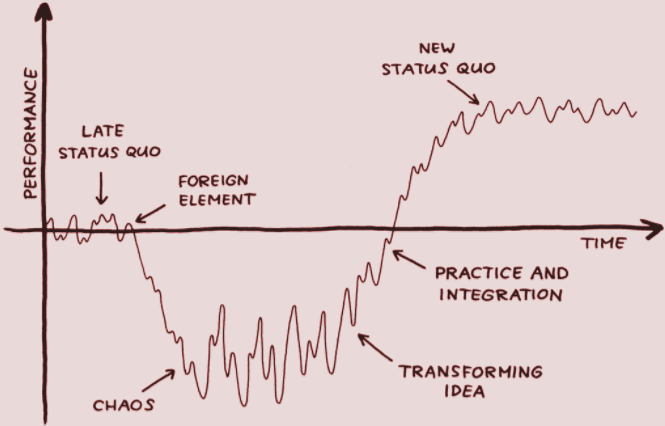Rewire your brain (Part 5) - The Satir Change Process Model

Software Engineering Team Lead and Director of Cloudsure
Virginia Satir says that we can learn something new anytime we believe we can. Therefore we can learn to cope with what we are dealing with by readjusting the way we think.
In the part 4, Survival Rules, we look at how we can identify childhood survival rules, analyze them and decide if they are beneficial today. Changing them is an interesting way of rewiring your brain as we change old behaviors as these rules no longer apply to the current day.
This model was developed by the "Mother of Family Therapy": Virginia Satir 1. It can improve your life by transforming the way you see and express yourself 2.
This model shows how you will predictably move through different stages as you cope with unexpected and significant or major changes 3.
It also describes the effects each stage has on your feelings, thinking, performance and physiology. The principles in this model can help you improve how you process change 2.

Virginia Satir Change Curve
Life is not what it's supposed to be. It's what it is. The way you cope with it is what makes the difference. ~ Virginia Satir
The Late Status Quo
This stage describes your ordinary day-to-day. Although your feelings can fluctuate you are still in familiar territory like pieces of a puzzle fitting together. You are used to how things work and flow in this stage.
Emotions may be fluctuating from comfort, contentment, happiness, excitement, to discomfort, dissatisfaction, unhappiness and depression or anxiousness.
The Foreign Element
All of a sudden something needs to change. Your expectations are challenged. Your familiarity is now shaken up due to unexpected information, a significant event, invalidated assumptions or maybe the realization that something you have been doing your whole life needs to change.
Chaos
Now you are outside your comfort zone in a big unknown mysterious place. You are in an unpredictable unfamiliar territory. This can be very scary by also offer some creativity.
So it may feel unsafe. You may feel strong emotions which may confuse you:
- Stress
- Confusion
- Discomfort
- Pain
- Fear
- Excitement
- Euphoria
- Strong sense of urgency
You could behave in ways that are unfamiliar to you:
- Trying to stay in control
- Disengaging and retreating to some familiar activity
- Focusing on one small part of the problem
- Ignoring the chaos happening around you
- Scrambling to find information about what is going on
This stage is vital to the transformation process so acknowledge your feelings and build and use support systems. It can be very creative and a lot of ideas can be generated here.
The Transforming Idea
A powerful idea generated in the Chaos stage could lead to the transformation process which sheds light on the change and helps you understand it more and cope with it. This is the AHA! moment.
You may not know it is a transforming idea so just try it and see what happens. If it's not, try something other AHA!
Practice and Integration
The more you practice this new behavior extracted from your transforming idea the more you integrate it into your life. It is a learning phase that allows for mistakes so your progress may ebb and flow.
You have the opportunity to decide what is working and what isn't which makes you more skilled and hopeful as you continuously learn.
The New Status Quo
Once you have fully absorbed the change you become more healthier, calmer and alert. You need to continue feeling safe in this space by practicing.
Emery sums it up elegantly by saying that:
- You feel good about how rapidly you are learning.
- You turn your attention toward other important areas of your life, armed with new skills, knowledge and confidence.
- Eventually these new skills become second nature.
- Your learnings become assumptions and expectations.
- With time, the newness fades, and the New Status Quo becomes a Late Status Quo.
- And the change cycle begins again.

The Satir Change Process Model Cycle
My final thoughts
This model can be used for any self-improvement need. Instead of tracking performance, you could be tracking quality of life over time. Our survival rules are deeply ingrained into us and we can pinpoint them, analyze them and decide if we still need it or not. If we don't need it, we can change it and this is just one model of how we can do so through reflection.
We don't want behaviors that cause:
- Exhaustion
- Misery
- Lack of focus and concentration
- Lack of self-care
- Lack of social interaction
- Lack of physical activity
- Problems with relationships
- Impending burn-out
There is a lot of material out there describing the model in detail. I just wanted to document the idea as a model to help rewire the brain to transform unhealthy behaviors to more positive behaviors. These stages show how a change can impact us and how we can get to a point where we can thrive.
References
-
Virginia Satir, Wikipedia (Navigate back)
-
The Satir Change Model, Steven M. Smith, Accelerating Team Productivity (Navigate back)
-
Managing Yourself Through Change, Dale H. Emery, Consultant to Software Teams and Leaders (Navigate back)
Resources
-
Framework 59 Virginia Satir Change Process, Organisational Change Management Volume 1, Bill Synnot and Associates
-
Virginia Satir Change Curve, Flicker, Jurgen Appelo says this illustration is part of the book Management 3.0
-
Think Visually When Building an Agile Enterprise Change Plan


